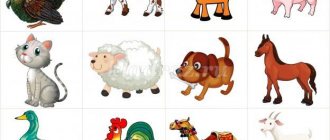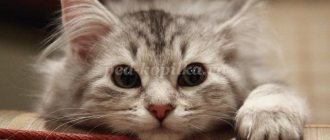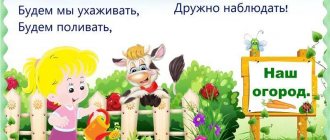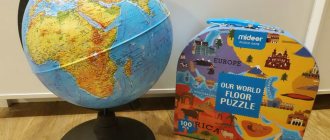Project "Pets" in the second junior group
Svetlana Vasilyeva
Project "Pets" in the second junior group
The type of project is educational and creative.
participants are teachers , parents, children 3-4 years old.
project manager is Svetlana Anatolyevna Vasilyeva.
duration – 2 weeks .
Project in the educational field “Cognitive Development”
.Integration with areas:
“speech development”
,
“social and communicative development”
,
“artistic and aesthetic development”
,
“physical development”
.
Problem.
Looking at pictures of domestic animals , the children were unable to answer the questions: “What are baby animals ?”
,
"Who lives where?"
,
“Who looks after them?”
,
“What do they eat?”
,
“What benefits do they bring to humans?”
The children did not have sufficient knowledge.
To answer these questions, we decided to conduct “
Pets ” project .
Relevance of the project .
It is necessary to instill the basics of environmental consciousness in children from early childhood. We need to teach people to take care of nature and protect it. Pets are part of nature . So let our children be environmentally educated, emotionally responsive, and capable of empathy.
The goal of the project : to enrich children's knowledge about domestic animals . Give children an idea of domestic animals and their cubs , their appearance, habits, and the role of animals in human life . Introduce children to their place of residence. Foster love, respect and caring attitude towards pets .
Project objectives .
Cognitive development: learn to recognize and name pets by appearance . Give an idea of what they eat. To consolidate the idea of domestic animals (they live next to people, people take care of animals , animals benefit people).
Develop the ability to distinguish between domestic animals and their cubs (cat-cat-kitten, dog-dog-puppy, goat-goat-goat, etc., imitate their voice. Develop cognitive activity. Cultivate in children a love for animals , a caring attitude towards him.
Speech development: develop skills in writing a short story about animals .
Develop the ability to answer questions and conduct dialogue.
Develop thinking, imagination, memory, enrich vocabulary.
Examination of a poster, illustrations, pictures about pets .
To develop children's interest in nature and emotional responsiveness. Learn to listen to works of art, memorize short poems, and solve riddles. To develop children's interest in oral folk art, Russian folk tales about domestic animals . Learn to dramatize short passages.
Social and communicative development: develop the ability to communicate with peers during gaming activities. During games, develop interest in the world around you.
Reinforce the rules of safe behavior when interacting with animals .
Cultivate an interest in the work of adults, provide all possible assistance in caring for pets .
Artistic and aesthetic development: develop creative abilities. Improve skills and abilities in drawing, modeling, and appliqué.
Learn to memorize and perform small songs, convey an artistic image and emotional mood in them.
Physical development: learn to convey the habits of domestic animals , develop all types of motor skills. Develop the ability to coordinate speech with movements. To create the prerequisites for a healthy lifestyle - wash your hands after interacting with animals .
Expected Result.
Children will formulate the concept of pets . Children will correctly name animals and their babies . Know what they eat. How to care for them. What benefits do they bring to people?
Cognitive interest in animals , and a desire to take care of them will appear.
Children's communication and creative abilities will expand. Children's vocabulary will be enriched.
Parents will become participants in the educational process.
Project implementation stages .
Stage 1 – Preparatory.
Aimed at enriching the development environment.
1. Selection of methodological literature on the topic of the project .
2. Selection of fiction, riddles on the topic “ Pets ”
.
3. Selection of visual teaching aids, demonstration material, a set of pet .
4. Involve parents in working on the project : making a book about pets , hats for dramatizations and outdoor games, a model “ Pets ”
, bring photos for the
“Our Favorites”
.
Stage 2 – practical. Project implementation .
Conducting educational activities with children on the topic of the project .
Cognition.
Topic : " Pets and their babies "
.
Objectives: Expand children's understanding of domestic animals and their cubs . Be able to distinguish different animals by their characteristic features. Enrich children's understanding of the behavior and nutrition of domestic animals . Introduce the role of an adult in caring for pets . Develop emotional responsiveness.
Theme " Poultry "
.
Objectives: To consolidate knowledge about poultry (appearance, method of movement, habitat, names of cubs)
.Learn to use words in speech: chickens, feathers, wings. Encourage students to listen carefully to the story and answer questions about its content.
Research activity “What does a cat eat?”
Communication.
GCD. Topic : “Who is screaming?”
Goals: coherent speech: teach children to compose a short story together with the teacher;
grammar: learn to name baby animals , form words using the suffix –onok-;
dictionary: distinguish words with opposite meanings (big-small)
;
sound culture of speech: clarify and consolidate the correct pronunciation of the sound “and”
, learn to regulate the pitch of your voice.
Topic: “Storytelling based on the painting “Cat with Kittens”
"
Reading the folk nursery rhyme “Kitsonka-murysonka”
.
Objectives: Learn to write a short story with the help of an adult. Activate adjectives and verbs in speech. Reinforce the use of diminutive names for baby animals .
Examination of a poster, illustrations, paintings about domestic animals . Conversation " Pets "
, about appearance, lifestyle, living, caring for them.
Composing stories “Find out who I am?”
Situational conversation “How do animals ?”
,
“If there were no pets ?” "How I take care of
pets " .
Word games: “Name the animal ”
,
“Who has who?”
,
“Call me kindly”
,
“Who is screaming?”
Making up riddles.
Fiction.
Reading "Goat-dereza"
,
“Kids and the Wolf”
,
“Ryaba Hen”
, E.
Charushin “About Tyupa”
, V. Suteev
“Who said meow?”
,
“Chicken and Duckling”
, S. Mikhalkov
“Kittens”
, E. Blaginina
“Kitten”
, S. Marshak
“Mustache-striped”
, V. Berestov
“Hen with Chicks”
.
Saying the nursery rhyme “Like our cat”
.Memorizing
“I love my horse”
,
“Pussy, pussy, pussy scat”
Guessing riddles
Safety.
Conversation “Don’t touch unfamiliar animals ”
,
“Don’t tease dogs”
,
“Don’t hurt
animals ” .
Health.
Conversation “Wash your hands after interacting with animals ”
Socialization.
D/i “Gather a family”
,
“Who loves what?”
,
“Where is my mom?”
,
"Who lives where?"
,
“Who is missing?”
,
“Get things in order”
Board games: cubes, lotto, puzzles on the theme of the project .
Dramatization game “Two funny geese”
,
"Fun Concert"
.
Table theater "Ryaba Hen"
,
"Cat, Rooster and Fox"
.
Role-playing games: “Journey to grandma’s village”
.
“Family”
(puppy)
for my birthday .
“Veterinary hospital”
,
“On the farm”
.
Construction Games: Animal Farm
,
“Dog Kennel”
,
“Pen for Buryonka”
.
Watching the cartoon “A Kitten Named Woof”
.
Motor activity.
P/n: “Cat and Mice”
,
“Kittens and Puppies”
,
“Cat and Chicks”
,
“Sparrows and the Cat”
,
“Guess by Movement”
,
“Fox in the Chicken Coop”
.
Finger gymnastics.
Productive activity.
Drawing “Fluffy kitten”
,
“Chicken”
- Purpose: to practice drawing round-shaped objects using gouache using the poking method.
Modeling “There are many chickens around the hen”
.Goal: to practice sculpting round objects. Encourage him to pinch off a small piece of plasticine for the beak, roll it into a ball and attach it correctly.
Application: “Hen with chicks”
,
"Sheep in the Meadow"
.
Origami "Puppy"
.Goal: learn to use a variety of applicative techniques.
Stencils, coloring pages based on the project .
Crafts from natural and waste materials on the topic of the project .
Music.
Pet Voice Selection .
"Grey cat"
music V. Vitlina sl. N. Naydenova.
"Dog"
M. Rauchwerger.
Listening to the song “Who Grazes in the Meadow”
music A. Pakhmutova, lyrics. Yu. Chernykh.
Society.
Take part in the production of the “ Pets ”
.
Reading works and riddles on the topic of the project .
Make hat-masks for outdoor games and dramatization games.
Set up a stand on the theme “Our favorites”
.
The final stage. The result of the project .
“ Pets ” layout has been created
The book
“
Animals Next to Us ” .
“Our Favorites”
stand has been set up .
As a result of the project :
1. Children have formed and enriched their understanding of domestic animals . Children recognize animals by appearance , know where they live, what they eat, what the baby animals , and how to care for them.
2. Making a model made it possible to visualize the habitat of pets
3. Children's vocabulary has expanded.
4. Children’s communication and creative abilities have expanded.
5. Children have become inquisitive, treat animals , and show a caring attitude towards them.
Progress of the lesson.
- Look - this is a clearing, green grass grows on it. A chicken came to the clearing and said: “Ko-ko-ko! I want to eat!"
. What does the chicken eat? That's right, grains. The chicken searches and searches for grains in the clearing - there are no grains. Let's feed the chicken and give her some tasty grains.
(Put on the green “clearing”
plasticine ball and invite the baby to press it with his finger.)
- Here is a grain and here is a grain. The chicken pecked the grains and said: “Ko-ko-ko! Thank you! Very tasty grains. I want more grains"
. Let's guys give the chicken a lot of grains!
(After completing the task, play up the result: a toy chicken will come to every clearing, peck at the grain on it, and praise each child.)
Productive GCD (Drawing)
on the topic of:
"Grass for a cow"
Goal: to teach children to hold a brush correctly in their hand; draw sticks - straight vertical lines; control the length of the line, its beginning and end; develop an interest in drawing.
Equipment: green paint; sheets of drawing paper (1/2 of an A4 sheet)
with blanks
(according to the number of children)
: a horizontal brown line is drawn at the bottom of the sheet - this is a clearing, on it is a cow.
Progress of the lesson.
- Look, guys, a cow came to our clearing. She is very hungry. “MU! I want to eat!"
. What does a cow eat? That's right, grass. Let's feed the cow, give her juicy, green grass.
- Let's draw vertical lines of green color - grass. (I show how to paint green grass with a brush)
.
— Green grass grew in the clearing.
(Give the kids sheets with blanks and brushes with green paints)
— You also have a cow grazing in your pictures. Draw green grass for her.
(After completing the task, praise the kids on behalf of the cow and treat them with milk.)
Entertainment in the second junior group
“Visiting grandma in the village”
.
Goal: To consolidate and expand children's initial knowledge about domestic animals and birds .
Tasks:
Educational:
— Foster a sense of love for the surrounding world, caring attitude towards the inhabitants of wildlife .
— Develop skills to work together.
Educational:
— Develop children’s mental processes: attention, memory, thinking.
— To promote the development of coherent speech and the articulatory apparatus when pronouncing vowel sounds using onomatopoeia.
- Continue to develop fine motor skills.
— Arouse positive emotions and interest in the process of sculpting with your fingers (use the pressing technique)
.
Educational:
— Strengthen children’s knowledge about pets .
— Reinforce the concept of poultry .
— Learn to distinguish the voices of pets and answer the teacher’s questions.
Methods and techniques: organizational aspect, game techniques, modeling, art. word, surprise moment, questions for children, health-saving technologies.
Vocabulary work: domestic animals , goat, cow, horse, cat, pig, dog, poultry , chicken, rooster, duck, goose.
Preliminary work:
— Looking at illustrations with pets .
— Watching a cat and a dog, reading thin. literature.
— Didactic game “Who is screaming?”
— Games of transformation into animals.
— Didactic game: “Who lives where?”
— Reading poems and riddles about animals.
— Learning Russian folk nursery rhymes.







